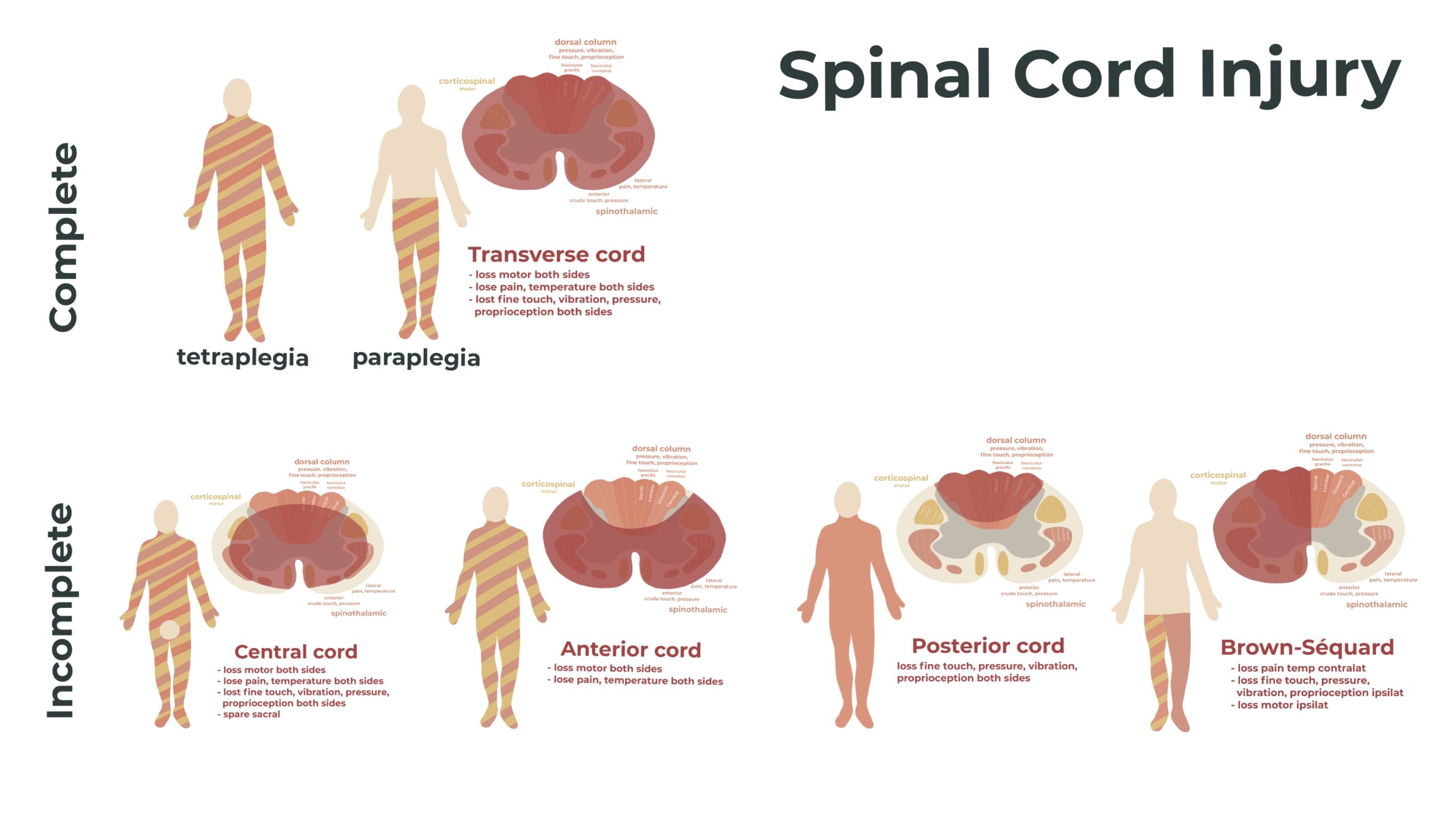Spinal Cord Injury Overview

Welcome to Spinal Cord Injury Lawyer’s comprehensive guide to different types of spinal cord injuries, their causes and effects, and the legal options available for persons who have suffered such injuries due to accidents caused by third parties. We understand the challenges you face, and we are here to provide you with the information and support that you need to seek justice and financial compensation.
Spinal cord injuries can be extremely costly, because the spinal cord is a crucial component of the central nervous system which transmits signals between the brain and the rest of the body. When the spinal cord is injured, consequences can be permanently life-altering and severely expensive. A spinal cord injury lawsuit is needed to cover such costs by gaining compensation for the victim of other persons’ negligence.
NAVIGATE THIS PAGE
Types of Spinal Cord Injuries
Spinal cord injuries generally involve two types: complete spinal cord injury and incomplete spinal cord injury.
1. Complete Spinal Cord Injury
In a complete spinal cord injury, there is a total loss of sensory and motor function below the level of the injury. Individuals with a complete SCI typically do not have sensation or voluntary movement in the areas below the injury site.The level of impairment depends on where the injury occurs along the spinal cord. For example, if the injury is at the neck (cervical) level, it can result in tetraplegia (also known as quadriplegia), affecting both the upper and lower limbs.
Paraplegia
Complete spinal cord injuries at lower levels often result in paraplegia, which is loss of function in the lower limbs. Paraplegia is a severe neurological condition characterized by the partial or complete loss of motor and sensory function in the lower half of the body, typically as a result of spinal cord injury.
Individuals with paraplegia experience paralysis of the legs and, in some cases, the lower trunk, affecting their ability to move or feel sensations below the level of the injury. This condition is distinct from quadriplegia (tetraplegia), which involves the loss of function in both the upper and lower extremities. The extent and severity of paraplegia depend on the specific location and nature of the spinal cord injury.
Lear More
Quadriplegia (Tetraplegia)
When the injury occurs high on the spinal cord, quadriplegia may result with loss of function for all four limbs. Quadriplegia is a neurological condition characterized by the partial or complete loss of motor and sensory function in all four limbs, as well as the trunk, due to a spinal cord injury or other severe neurological disorders. Unlike paraplegia, which affects the lower half of the body, quadriplegia involves impairment in both the upper and lower extremities.
The degree of impairment in quadriplegia varies based on the location and severity of the spinal cord injury. Injuries higher up on the spinal cord, particularly in the cervical region, generally result in more extensive loss of function. Individuals with quadriplegia may experience challenges with voluntary muscle control, coordination, and sensation, impacting daily activities and mobility.
Medically some quadriplegics are referred to as ventilator dependent quadriplegics due to the very high cervical injury resulting in permanent paralysis and near total loss of sensory function to the entire body and of course the full time need of an external ventilator to breath and stay alive.
Complete spinal cord injuries have limited potential for recovery. Persons often require extensive medical care and rehabilitation, as well as lifelong support.
Such support can include:
- Mobility aids: Providing wheelchairs, mobility scooters, or other assistive devices.
- Home modifications: Adding ramps, widened doorways, and other adjustments to make homes accessible.
- Financial and legal matters: Navigating insurance claims, disability benefits, and legal actions against responsible parties.
Lear More
2. Incomplete Spinal Cord Injury
An incomplete spinal cord injury describes to damage to the spinal cord that partially disrupts the transmission of signals between the brain and muscles.
In an incomplete spinal cord injury, some sensory or motor function remains below the level of the injury. The degree of impairment and paralysis can vary widely. Some individuals may retain significant function and sensation, while others may have limited function.
The in a normal healthy body, the brain and body communicate by passing signals through the spinal cord and peripheral nerves. When the neural pathways that transmit signals become damaged, signals can no longer reach their desired destination along the spinal cord. Individual with an incomplete spinal cord injury, experiences a loss of sensation and muscle and motor control below their level of injury after a spinal cord injury.
Read More
With an incomplete spinal cord injury, some degree of sensory or motor function may remain below the level of the injury. The extent of impairment and potential for recovery can vary widely, but common outcomes can include:
- Partial paralysis: Some muscle function is retained in certain areas, allowing for limited movement and sensation.
- Variable recovery: Depending on factors such as location and severity of the injury, persons may have varying degrees of recovery over time.
- Hemiplegia: Injury to one side of the spinal cord can cause paralysis on either the left or right side of the body.
- Monoplegia: This means paralysis of one limb of the body, usually an arm but sometimes a leg.
Triplegia: This means total and irreversible paralysis of three limbs of the body, often both legs and one arm.
Incomplete spinal cord injuries involve more hope for rehabilitation and an improved quality of life than do complete spinal cord injuries.
Regardless of the type, spinal cord injuries also can take a significant toll on a person’s mental and emotional well-being. Grief, anger, depression, and anxiety are common as people adapt to life-altering changes.
ASIA Impairment Scale for Spinal Cord Injuries

The American Spinal Injury Association (ASIA) Impairment Scale to measure the extent of spinal cord injury (SCI) can be broken down into the four classifications. The ASIA Impairment Scale assigns the SCI a grade based on its severity. Grades range from A to E, with A being the most severe injury and E being the least severe.
• ASIA A = Complete Spinal Cord Injury: Complete sensory or motor function loss below the level of injury.
• ASIA B = Incomplete Spinal Cord Injury: Sensation is preserved below the level of injury, but motor function is lost.
• ASIA C = Incomplete Spinal Cord Injury: Motor function is preserved below the neurologic level, and most key muscles below the neurologic level have a muscle grade of less than 3
• ASIA D = Incomplete Spinal Cord Injury: Motor function is preserved below the neurologic level, and most key muscles below the neurologic level have a muscle grade that is greater than or equal to 3
• ASIA E = Normal: Sensory and motor functions are normal
Effects of Spinal Cord Injuries
Spinal cord injuries can have serious physical effects, which vary depending on the level and severity of the injury. Common physical effects include:
- Paralysis: Loss of muscle function in specific areas, leading to conditions such as paraplegia or quadriplegia. (See below.)
- Loss of sensation: A reduced or complete loss of sensation below the level of the injury, affecting touch, temperature, and pain perception.
- Bladder and bowel dysfunction: Loss of control over bladder and bowel functions.
- Respiratory Issues: Loss of respiratory muscles’ control, requiring ventilator support.
Common Causes of Spinal Cord Injuries
Spinal cord injuries can have various causes, but accidents are a significant contributor. Understanding such causes is essential for determining legal liability in seeking compensation.
Common causes of spinal cord injuries include:
Collisions involving cars, motorcycles or trucks can lead to severe spinal cord injuries. Negligent driving, reckless behavior and failure to follow traffic rules can all contribute to accidents resulting in spinal cord injuries.
Slip and fall accidents can occur on poorly maintained property with hazards such as wet floors, uneven surfaces or insufficient lighting. Property owners and managers may be liable for injuries suffered on their premises if negligence can be proven.
High-impact sports and recreational activities can lead to spinal cord injuries when safety precautions are inadequate. Coaches, event organizers and equipment manufacturers may share responsibility for such injuries.
Inadequate safety measures and other workplace negligence can put employees at risk of accidents causing spinal cord injuries. Employers have a duty to provide a safe working environment and may be held liable for injuries resulting from their negligence.
Construction workers are especially susceptible to falls from heights, machinery accidents and other incidents that can lead to spinal cord injuries. Employers and contractors must ensure proper safety protocols are in place.
Spinal cord injuries also can result from medical procedures or surgeries gone wrong. Errors during spinal surgeries, misdiagnosis or improper post-operative care can lead to devastating consequences. Medical professionals and facilities can be held accountable for medical malpractice.
Defective products, such as faulty seat belts, vehicle roofs, airbags or safety equipment in vehicles, can contribute to spinal cord injuries during accidents. Manufacturers and designers can be held liable for these defects.
Spinal Cord Injury Legal Recourse
If you or a loved one has suffered a spinal cord injury due to the negligence of a third party, defective product or other at fault party, you may have the right to seek compensation for your damages. Such compensation can include payments for medical expenses, lost wages, pain and suffering, and other damages.
Understanding the type and cause of your spinal cord injury is essential in determining a legal recourse. Such legal actions can involve:
Personal Injury Claims
Filing a personal injury claim against an at-fault party allows you to seek compensation for medical expenses, lost wages, pain and suffering, and other damages. Personal injury claims are typically the primary legal recourse for spinal cord injuries resulting from accidents.
Product Liability Lawsuits
If a defective product contributed to your spinal cord injury, you may have grounds for a product liability lawsuit against the manufacturer or designer of the faulty product. These lawsuits aim to hold manufacturers accountable for injuries caused by their defective products.
Medical Malpractice Lawsuits
If your spinal cord injury resulted from medical malpractice, pursuing a medical malpractice lawsuit can help you seek compensation for your damages. These lawsuits target negligent healthcare providers and facilities.
Seek Legal Representation Now
Seeking experienced legal representation is crucial to ensuring that your legal rights are protected and your spinal cord injury case is pursued vigorously.
At Spinal Cord Injury Lawyer, we specialize in representing individuals who have suffered spinal cord injuries due to accidents caused by third parties. Our experienced legal team understands the intricacies of these cases and is dedicated to fighting for your legal rights.
We have a proven track record of securing substantial financial compensation for our clients, thus providing them with the resources they need for their recovery and their future well-being.

Listen to What Some of Our Formers Clients Have to Say
Please take time to read over our past results studies to see how we have helped persons with paraplegia and quadriplegia to achieve justice and financial compensation. We are committed to fighting for our clients’ rights and ensuring that they receive the financial recovery they deserve.
Arthur R.
Marcus G.
Joseph S.
David W.
Ofelia P.
Contact a Spinal Cord Injury Lawyer – Free Case Review
If you or a loved one has suffered a spinal cord injury due to someone’s negligence, contact us today for a free legal consultation. Spinal cord injuries from accidents often are life-changing, requiring extensive medical care and significant changes in a person’s daily existence. This can be extremely costly, but such costs should not be borne by the injured person. Rather, spinal cord injuries due to someone else’s negligence are the legal responsibility of the third party which caused the accident injury, or their insurance provider. Those payments must be won in the legal arena.
Our compassionate and knowledgeable legal team is here to guide you through the legal process. We can ensure that your legal rights are protected and can fight for the financial compensation or economic payments you deserve. Your journey to justice and recovery begins with an experienced Spinal Cord Injury Lawyer.
Let Us Help You
Request Your FREE CONSULTATION Today!
Call (800) 883-2020 or fill out the form below to contact our team.
